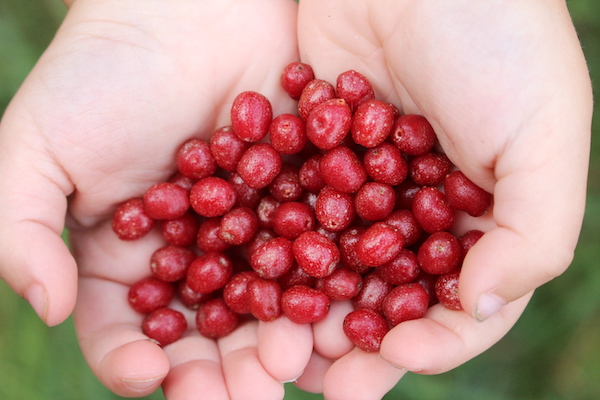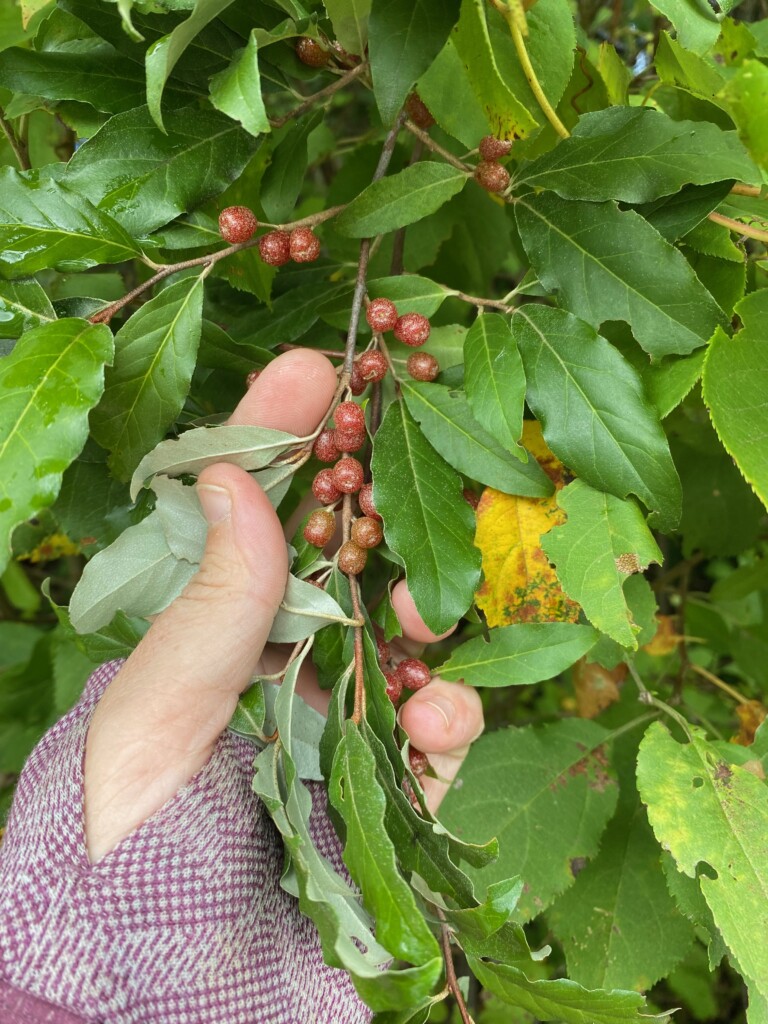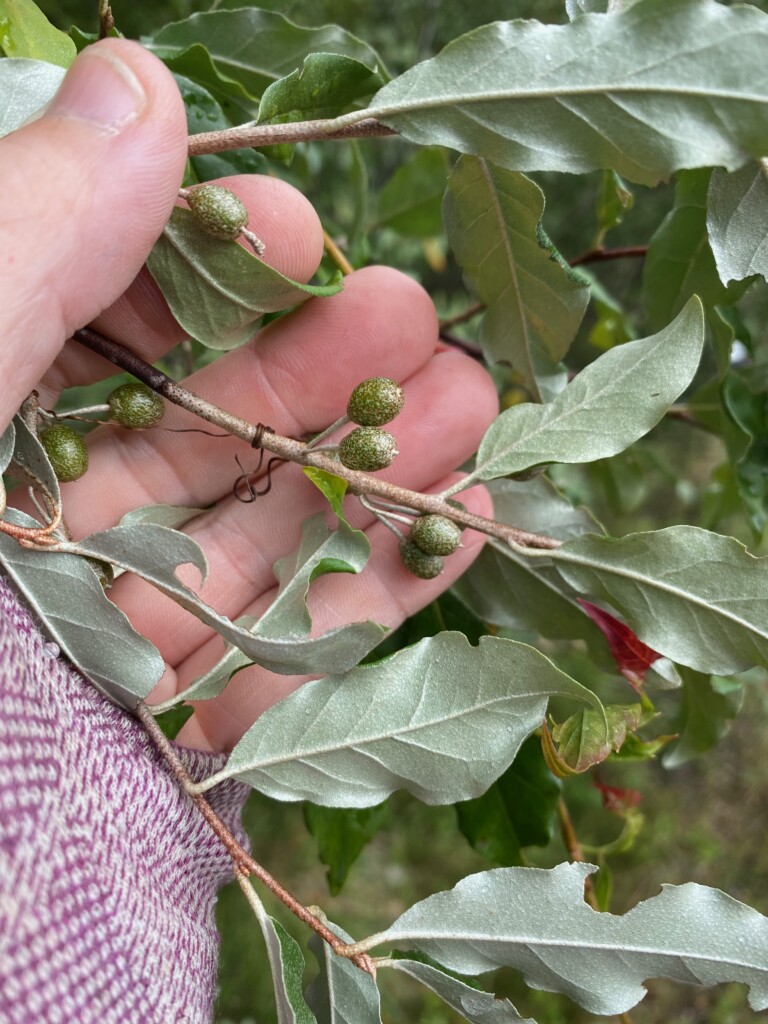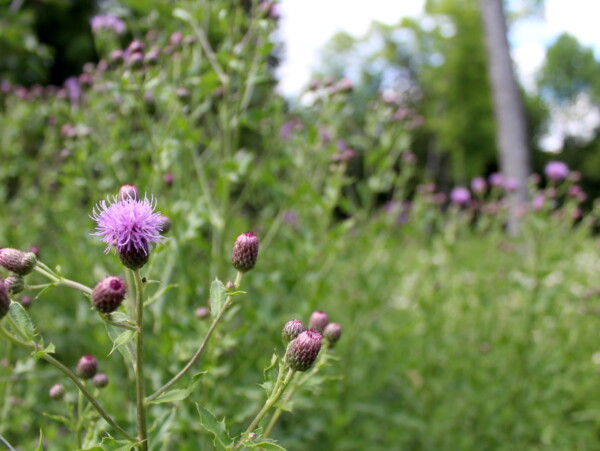Affiliate disclosure: This post may contain affiliate links. Please see our Privacy Policy.
Autumn Olive (Elaeagnus umbellata) is a tasty edible wild fruit that ripens late in the fall. The plants are nitrogen fixers, which means they can grow on incredibly poor soil. Combine that with exceptional cold hardiness, and they’re the perfect fruit to forage where little else will grow.

Autumn olive (Elaeagnus umbellata) is one of the most prolific wild fruits you’ll find, and it’s a favorite for foragers willing to embrace this abundant plant. Though often labeled invasive, it produces an incredible bounty of tart-sweet berries each fall, perfect for jams, sauces, and snacking right off the bush.
I first stumbled onto a massive thicket of autumn olive while hunting for wild grapes, and the sheer volume of fruit was staggering. Once you know what to look for, you’ll see autumn olive everywhere—and you’ll never leave empty-handed.

What is Autumn Olive?
Autumn olive (Elaeagnus umbellata) is a deciduous shrub or small tree originally from Asia, introduced to North America for erosion control and wildlife habitat. It has since naturalized widely and is considered invasive in many areas, particularly in the eastern and central United States.
Autumn olive grows quickly in poor soils, disturbed areas, fields, and along roadsides. It’s a hardy perennial that thrives in full sun and poor conditions where few other plants can survive.

Is Autumn Olive Edible?
Yes, autumn olive berries are edible, and quite nutritious. The ripe berries are tart and sweet, with a unique flavor often described as a cross between pomegranate and tomato. They are best eaten fresh, cooked into jams and sauces, or dried.
Autumn olive berries are particularly high in lycopene, an antioxidant compound also found in tomatoes. However, the seeds inside are best swallowed whole or spit out, as they can be slightly astringent if chewed.
Their high lycopene content (like tomatoes) inspired quite a few autumn olive ketchup recipes among forager friends, and they’re all delicious. It works out particularly well since you pass the autumn olives through a food mill to remove the seeds.

Autumn Olive Medicinal Benefits
Autumn olive berries are renowned for their extremely high lycopene content—often higher than tomatoes. Lycopene is associated with antioxidant benefits, including supporting heart health and potentially reducing cancer risk.
In traditional practices, autumn olive has also been used for general immune support and as a mild astringent.
That said, this is one of the few wild edible plants with very little documented medical research. While wild black cherry is great for coughs, and teaberry is great for nerve pain, Autumn olive’s medicinal actions remain a mystery as it hasn’t been studied nearly as much as other wild edible fruits and berries.

Where to Find Autumn Olive
Autumn olive is widespread across the eastern and central United States, thriving in sunny, disturbed areas like abandoned fields, pastures, roadsides, and open woodlands. It tolerates poor, sandy, or rocky soils and can quickly colonize areas where other plants struggle.
You’re likely to find it forming dense thickets wherever the ground has been cleared or disturbed.

When to Find Autumn Olive
Autumn olive flowers in late spring, producing small, fragrant, creamy-yellow blooms. The fruit develops through summer and ripens in early to mid-fall, usually from September through November depending on location.
Look for ripe berries when the leaves begin to yellow in autumn.

Identifying Autumn Olive
Autumn olive is a spreading shrub that typically grows 6 to 20 feet tall. It has a bushy growth habit with multiple stems arising from the base. The key to identifying autumn olive lies in its silvery foliage and abundant clusters of small red berries.
As is typical with an invasive species, autumn olive trees grow quickly — the shrub begins producing fruit when it’s three years old and has an average fruit-producing lifespan of 40 years.

Autumn Olive Leaves
Depending on where you live, autumn olive leaves first begin to appear in March and throughout early May, with each leaf growing from 2 to 4 inches in length.
The leaves are an elongated oval, or elliptical, shape and grow alternately (this means that one leaf grows from each plant node on alternate sides of the branch). The edges of the autumn olive leaf are classified as being undulate, or wavy, and has an entire margin, meaning the leaf has no teeth or serration marks.
The tops of the leaves are green, while the undersides are distinctly silvery and covered in tiny scales, giving them a shimmery appearance.

As you can see in the pictures below, the topside of the leaf is a true green, while the underside is more of a slate green flecked with small golden-brown spots.
You’ll also notice the underside of the leaf has a rougher, scaly texture while the topside is comparatively smooth.
While the leaves are relatively nondescript from a distance, looking at the undersides will really help you identify Elaeagnus species.

Autumn Olive Bark
The twigs on a young autumn olive tree are a lighter shade of brown with a silvery patina, you’ll also see small tawny-colored scales speckling the branches. The thorns on young branches are typically quite long, so take care when you’re scouting out possible foraging locations!
As the tree ages and grows, the color of the bark turns to a light gray or grayish-brown color. You’ll notice that the bark on mature autumn olive trees is more fibrous and that it peels off in long, narrow strips.
Young stems are often brown or olive-green and speckled with silver or brown scales. Older stems become gray and woody.
Some plants produce small thorns, but many do not.

Autumn Olive Flowers
The flowers are small, tubular, creamy-yellow, and highly fragrant. They bloom in clusters in late spring and are an important nectar source for pollinators.
The blooms from the autumn olive tree have a strong floral scent — the aroma is often compared to lilies. You’re most likely to smell them from April through June, when they’re in full bloom.
The tubular flowers are light yellow or cream-colored with bright yellow stamens; each flower has four petals. The blooms typically grow in clusters of 1 to 10 flowers.
I’ve actually found these plants by their scent in spring, literally following my nose to a patch.

Autumn Olive Fruit
The berries are small (about 1/4 inch across), round to slightly oval, and bright red when ripe, often with silver speckles on the surface. They grow in dense clusters and are easily stripped from the branches by hand.
Unripe autumn olive fruits, or autumn berries, are small and silvery green.

Once the fruit has fully matured — in September and October — the berries turn a bright speckled red or pink.
They’re best after a light frost in late autumn, but I think they’re great eating as soon as the leaves start to yellow even if there hasn’t been a frost yet.

Autumn Olive Look-Alikes
Autumn olives are fairly easy to identify but there are a few look-alikes to be aware of. When in doubt, remember that autumn olive trees will always have alternate leaves and small scales covering the bark, the underside of the leaf, and the fruit.
All three of these closely related species are edible, and look quite similar.
- Russian Olive (Elaeagnus angustifolia): Russian olive also has silvery foliage but produces dry, mealy fruits that are yellowish rather than red.
- Silverberry (Elaeagnus commutata): Native to parts of North America, silverberry fruits are silver or grayish and not red when ripe.
- Buffaloberry (Shepherdia argentea): Buffaloberries have similar red fruits but grow on thornier shrubs with grayish leaves and are native to western North America.
The main look alike to watch out for are invasive honeysuckles, which looks a good bit like autumn olive and is toxic.
- Japanese Honeysuckle (Lonicera japonica): Japanese honeysuckle is a climbing vine, not a shrub, and while it has red berries, they are toxic and the plant lacks the distinctive silvery foliage of autumn olive.
- Buck Honeysuckle (Diervilla spp.): Sometimes mistaken for autumn olive. Most noticeably, invasive honeysuckle is much smaller, reaching only 3 to 5 feet in both length and width. Unlike the autumn olive tree, which has alternate leaves, honeysuckle leaves grow opposite to one another and there are no silvery scale-like marks on the leaves or bark.
Harvesting autumn olive
Autumn olive fruit is at its sweetest when it’s been allowed to fully ripen on the stem. While your mileage may vary depending on where you live, I can typically harvest these berries all the way through December. The longer you can wait, especially if you can hold off until after the first frost, the tastier autumn olive berries will become.
A word of warning: Unripe autumn olive berries have an intensely astringent flavor and can cause stomach upset for some people.

These berries can be somewhat tedious to pick one-by-one, so I recommend gently shaking them directly from the branch into a bucket, removing any smalls twigs or broken leaves from the berry pile as you work.
If you plan on processing the berries for jam (or any other recipe that involves a sieve or straining step), you don’t have to be as careful picking out extraneous bits of autumn olive detritus.

Recipes Using Autumn Olives
Autumn olive berries have a deep, jammy flavor, making them ideal for dessert recipes and homemade condiments. My kids love it when we make autumn berry fruit leather — it’s an activity the whole family can do together.
If you’re looking for autumn olive inspiration, give these recipes a try!
- Autumn Olive Ketchup from Learning and Yearning
- Autumn Olive Cookies from Edible Wild Food
- Lemon and Autumn Olive Tart from Edible Wild Food
- Autumn Olive Fruit Leather from The Cook’s Cook
- Autumn Olive Jam from Creative Canning

Edible Wild Fruit
If you’re out gathering autumn olive, keep an eye out for other fruits ripening around the same time. Chokecherries often hang heavy along streams and roadsides in early fall, providing tart fruits perfect for jelly. Wild grapes climb through hedgerows and abandoned fields, offering small but intensely flavored clusters.
Later in the fall, you might stumble across hawthorns, whose small apple-like fruits ripen just as autumn deepens. Northern wild raisin (Viburnum cassinoides) produces sweet fruits that become better after a frost, as does Highbush Cranberry. Along the way, you might also spot wild apples and rose hips, each offering their own bounty for the autumn forager.
And if you’re adventurous, you can even find Solomon’s Plume this time of year too.
With a sharp eye and a few good gathering bags, fall can fill your pantry with more wild fruit than you might have thought possible!















If there are no autumn olive trees near where I live, are dried silverberries a good alternative in terms of lycopene content?
I believe so, but I’m not 100% sure.
Have you tried making wine with these berries?
I haven’t personally tried this but I have seen others who have. If you decide to try it, be sure to let us know how it goes.
Ashley – I love following your page and newsletter. Do you have a book out yet where i can find all this great info for my off-grid library?
Sorry Dee, there is no book at this time. Lots of people have asked so maybe one day.
I love this post! I have been foraging autumn olives for years, and always make what I call my “Christmas” jam. I have found that cinnamon complements Autumn Olives, Some cinnamon added to the jam makes the flavor reminiscent of autumn and winter. A taste of the holidays all year ’round! I would give my specific recipe, but it varies depending on the size of the harvest and the types of berries I mix in and their various natural pectin levels. I am going to try the lemon and autumn olive tart listed in the article.
As for harvesting, I just dip branch into a bag and slide those berries in. I have found trees so abundant that i have collected a gallon of berries in 5 minutes or less. Of course in suburbia, I make sure that anything I forage is away from roads.
That’s wonderful and your jam sounds amazing. So glad you enjoyed the post.
My favorite use of the autumn olive berries is in my Autumn-Raz Jam. I use a ratio of 2-1 or 3-1 (autumn olive to raspberries, frozen or fresh), and prefer Pomona’s Pectin, allowing a soft gel set with less sugar. The color of the jam is intensely scarlet, and the flavor is equally potent, in the very best way! Great on toast, or as the base layer of a shortbread fruit tart.
That jam sounds amazing!
Great information! Wish there were better pictures.. sorry but thanks!
Wow that’s great information to know since I have bookoos of these on my little farm! 😃 I had tasted a couple of the berries before but I didn’t know they were actually harvested by anyone other than the birds and deer! Haha